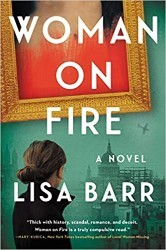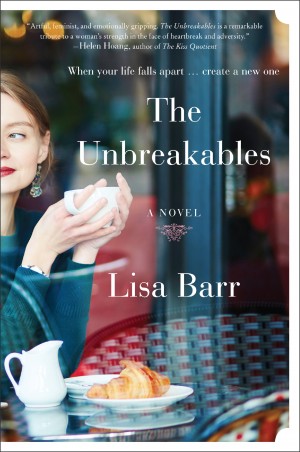Lisa Barr is the author of the award-winning debut novel, Fugitive Colors (Arcade), a suspenseful tale of an artist’s revenge on the “eve” of WWII. Today, she chimes in on the on-going conversation about Hitler, the Holocaust, and art for Jewish Book Council.
 In 1991, I was serving as the managing editor of a women’s magazine based in Chicago. I was sent on an assignment to cover the “Degenerate Art” Exhibit at the Art Institute of Chicago. Entering the museum, I literally stopped in my tracks – I had found my story. Even as a daughter of a Holocaust survivor, I never knew about the Nazis relentless mission to destroy the avant-garde – particularly painters. Hitler and his henchmen went after the German Expressionists with a vengeance never seen before, and I was blown away by what I discovered.
In 1991, I was serving as the managing editor of a women’s magazine based in Chicago. I was sent on an assignment to cover the “Degenerate Art” Exhibit at the Art Institute of Chicago. Entering the museum, I literally stopped in my tracks – I had found my story. Even as a daughter of a Holocaust survivor, I never knew about the Nazis relentless mission to destroy the avant-garde – particularly painters. Hitler and his henchmen went after the German Expressionists with a vengeance never seen before, and I was blown away by what I discovered.
At the time, I was already 150 pages into writing my first manuscript about young terrorists, but after that exhibit, I simply stopped writing that novel. I couldn’t sleep. I remember staying up all night, staring out the window – thinking who were those artists whose works were stolen, whose hands were tied, and whose canvases were destroyed and confiscated?
What if someone had stolen my computer, smashed my printer, took all my research, forbade me from entering bookstores, and destroyed all my past work, as though I never existed?
What if someone decided that my passion had to be quashed, or else?
No sleep morphed into even less sleep, as I began to outline a story. I wanted to take this unknown part of Holocaust history and somehow bring it alive through fiction; to usher in the hard history through the back door. As a writer, I love to teach, but first I knew I had to learn.
I needed to go back and really get a feel for what it was like to be a young artist in the early ‘30s, living in the whirlwind of German Expressionism.
Expressionism is not about painting the subject, rather it’s about painting how the subject makes you feel. It was a touchy-feely movement of art – chaotic, wild, colorful, fantasy-like – a movement that went against the Aryan grain of organization and control, but one that was taking the world by storm.
I delved into past interviews, historical accounts, books, personal histories, documents, paintings – I am a writer, not a painter but in order for my work to be real I needed to actually feel, smell, touch a canvas, as though I, too, were there. I needed to write this through the eyes of a young artist whose paintings were being stolen out from under him, and experience what that was really like.
The hardest part of being a writer or an artist is having the inclination but not the talent. Rejection, as we writers know all too well, is the deepest of all artistic pain, and this is where Hitler came in.
For Hitler, his mission to destroy the avant-garde was not political – it was personal. Yes, Hitler before he became “Hitler” was a painter. He had been rejected twice from the Academy of Fine Arts in Vienna. He resorted to selling painted postcards on the street and later house painting – his dream of living as a celebrated painter never being realized. He had been told repeatedly that he was not good enough, and to go find another trade to survive.
One wonders how things might have been, had he been “accepted.”
I truly believe that these early rejections set the stage for what would come later…the rape of Europe’s masterpieces, and the destruction of artists who didn’t play by Hitler’s rules. Once real power was in Hitler’s hands, he decided what was good enough, what was considered art.
It was no secret in Germany that Hitler despised the avant-garde – particularly Cubists, Dadaists, and Surrealists, and especially his homegrown German Expressionists, who fell into two groups of artists – Die Brucke (The Bridge) and Der Blaue Reiter (The Blue Rider) – originating from Berlin, Dresden and Munich – and labeled them “Degenerate artists.” Among the name “Degenerates” were Beckmann, Kirchner, Marc, Dix, Nolde, and Heckel. Supplies stores were shut down, galleries were boarded up, museums were closed down, artists who did not comply with the Aryan rule book were forbidden to exhibit and sell their art. Artists were forced to hide; others fled, many committed suicide, and many others were imprisoned and murdered.
Hitler’s war began with the destruction of the avant-garde, and now ironically, 70 years later, this is the piece of Holocaust history still making front-page news.
This past November, Germany dropped its looted art bombshell: a cache of 1,500 masterpieces (Picasso, Matisse, Chagall, among them) worth more than $1 billion was discovered in a German apartment. Prior to that, in October, it was announced that Dutch museums had uncovered 139 artworks “likely” looted by the Nazis. Last month, Canada announced the “hunt” was on for looted art hiding in its museums and private collections. And just a few days later, Austria announced that a house in Salzburg is being “probed” for stolen art (coincidentally owned by the Gurlitt family, the very same owners of the art-looted apartment in Germany). A week ago, France returned over 100 stolen paintings.
One wonders if the critically-panned Clooney-led production of The Monuments Men had anything to do with the recent “outings.” Despite its Hogan’s Heroes-ish treasure hunt theme, the film did succeed in bringing this part of Holocaust history to the masses and further expose the world’s dirty little secret: The Nazis were not the only bad guys in town.
 One thing is clear: This country-by-country exposure will soon travel from Europe to our own doorstep – where similar murky “unknown” histories of beloved artworks hanging in major museum and private collections will surely be unveiled.
One thing is clear: This country-by-country exposure will soon travel from Europe to our own doorstep – where similar murky “unknown” histories of beloved artworks hanging in major museum and private collections will surely be unveiled.
Like everything else, it’s all just a matter of time.
While we are busy uncovering the lost histories of paintings worth millions still residing in the slippery hands of “The Alleged and The Guilty” – let us not forget the plight of the artists themselves. Paintings have a canvas, but passion has a face. Behind every “surviving” Picasso, were also scores of young, aspiring artists whose potential brilliance – whose expression – will never see the light of a canvas.
Read more about Fugitive Colors here.
Related Content:
- Essays: An Artistic Eye
- The Invisible Bridge by Julie Orringer
- Writing Through the Artist’s Perspective by Alyson Richman
Lisa Barr is The New York Times bestselling author of Woman on Fire, The Unbreakables, and the award-winning Fugitive Colors. She has served as an editor for The Jerusalem Post, managing editor of Today’s Chicago Woman and Moment magazine, and as an editor and reporter for the Chicago Sun-Times. She has appeared on Good Morning America and Today for her work as an author, journalist, and blogger. She lives in the Chicago area with her husband and three daughters.



